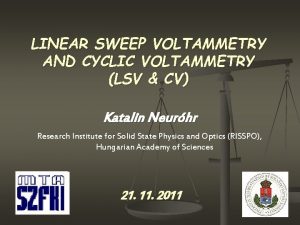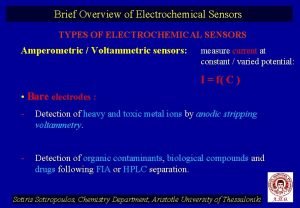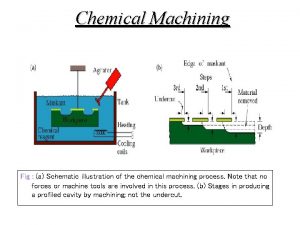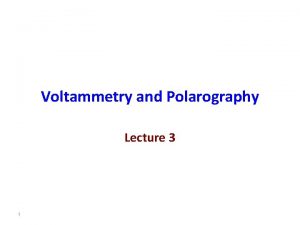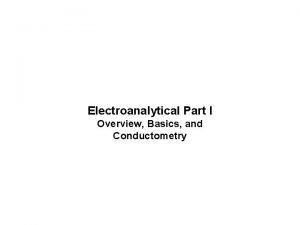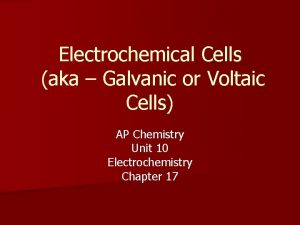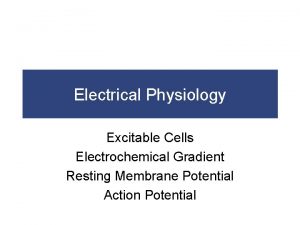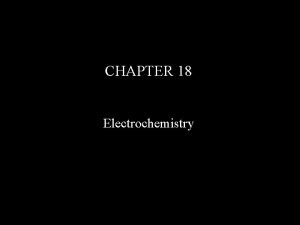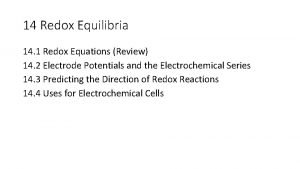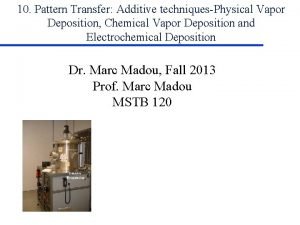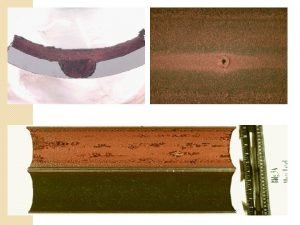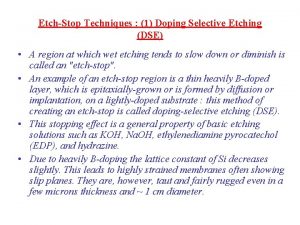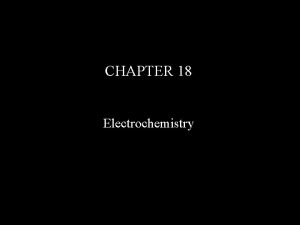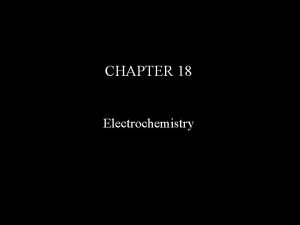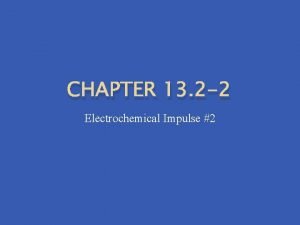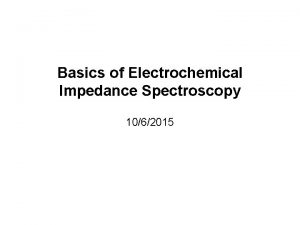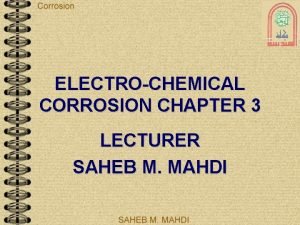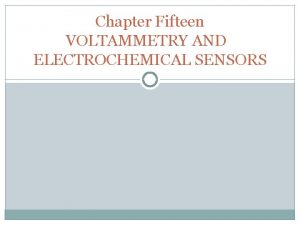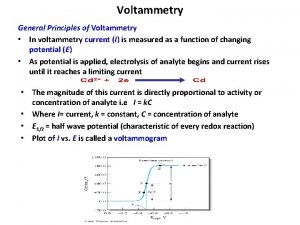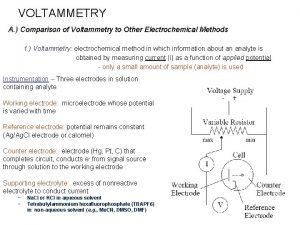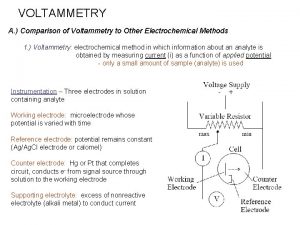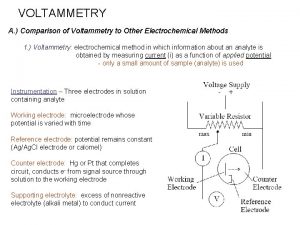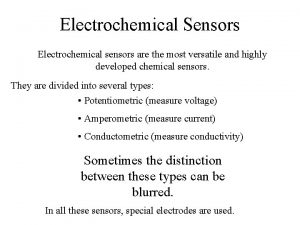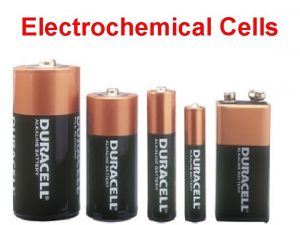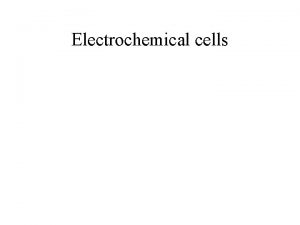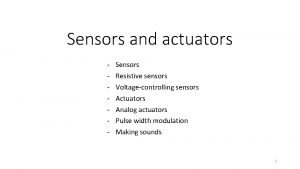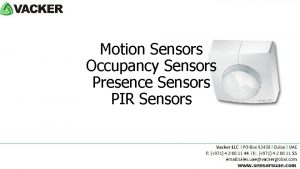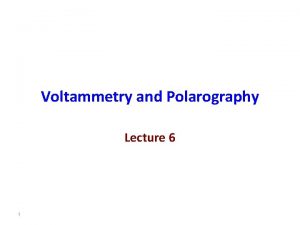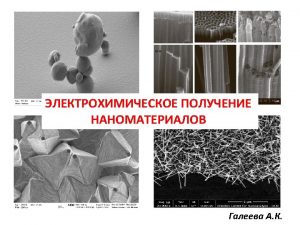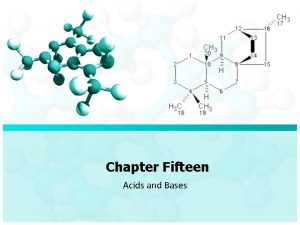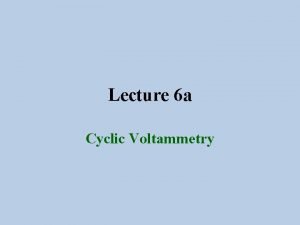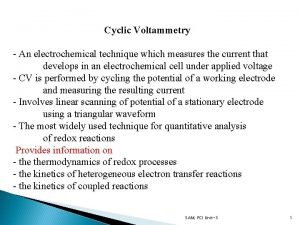Chapter Fifteen VOLTAMMETRY AND ELECTROCHEMICAL SENSORS WE WILL





























- Slides: 29

Chapter Fifteen VOLTAMMETRY AND ELECTROCHEMICAL SENSORS

WE WILL LEARN FROM THIS CHAPTER ●Electrolytic cells ● Current–voltage curves ● Supporting electrolytes ● Amperometric electrodes ● Chemically modified electrodes ● Ultramicroelectrodes

VOLTAMMETRY AND ELECTROCHEMICAL SENSORS 1 - Electrolytic methods include some of the most accurate, as well as most sensitive, instrumental techniques. 2 - In these methods, an analyte is oxidized or reduced at an appropriate electrode in an electrolytic cell by application of a voltage. 3 - The amount of electricity (quantity or current) involved in the electrolysis is related to the amount of analyte. 4 - The fraction of analyte electrolyzed may be very small, in fact negligible, in the current–voltage techniques of voltammetry. 5 - Micromolar or smaller concentrations can be measured. Since the potential at which a given analyte will be oxidized or reduced is dependent on the particular substance. 6 - selectivity can be achieved in electrolytic methods by appropriate choice of the electrolysis potential. 7 - Owing to the specificity of the methods, prior separations are often unnecessary. These methods can therefore be rapid.

15. 1 Voltammetry 1 - Voltammetry is essentially electrolysis on a microscale, using a micro working electrode (e. g. , a platinum wire). 2 -It is a current–voltage technique. 3 - The potential of the micro working electrode is varied (scanned slowly) and the resulting current is recorded as a function of applied potential. 4 - The recording is called a voltammogram. 5 - If an electroactive (reducible or oxidizable) species is present, a current will be recorded when the applied potential becomes sufficiently negative or positive for it to be reduced or oxidized. [By convention, a cathodic (reduction) current is taken to be positive and an anodic (oxidation) current is taken to be negative]. 6 - If the solution is dilute, the current will reach a limiting value directly proportional to its concentration.

In voltammetry, the potential is scanned at a microelectrode, and at a certain potential, an electroactive analyte is reduced or oxidized. The current increases in proportion to the analyte concentration

THE VOLTAMMETRIC CELL—AN ELECTROLYTIC CELL 1 - A voltammetric cell consists of the micro working electrode, the auxiliary electrode, and a reference electrode, usually an Ag/Agcl electrode or a saturated calomel electrode (SCE). 2 - A potentiostat varies the potential of the working electrode, relative to the reference electrode, which has a fixed potential. 3 - The current passing through the working electrode is recorded as a function of its potential measured against the reference electrode, but the voltage is applied and current passes between the working and auxiliary electrodes, as in Figure 15. 1.


4 - The current–voltage curve is not disturbed by an appreciable solution resistance, which creates an i. R drop (voltage drop) between the working and auxiliary electrodes, as in nonaqueous solvents. 5 - Ohm’s law states that voltage is equal to the product of current and resistance: E = i. R where: i is the current in amperes and R the resistance in ohms. When current flows, the recorded potential is distorted— shifted—by an amount equal to i × R, where R is the solution resistance


THE CURRENT—VOLTAGE CURVE——THE BASIS OF VOLTAMMETRY Potentials in voltammetry are by convention referred to the SCE. The following relationship can be used to convert potentials versus SCE to the corresponding potentials versus normal hydrogen electrode (NHE), and vice versa: Evs. SCE = Evs. NHE − 0. 242 (15. 1) This relationship can be used to calculate the applied potential required for the electrolysis of the test ion at the microelectrode. Example we place a 10− 3 M solution of cadmium nitrate in the test cell with a carbon microelectrode and impress a voltage difference between the working and auxiliary electrodes, making the microelectrode negative relative to the SCE.

The electrode reaction will be Cd 2+ + 2 e− → Cd E 0 = − 0. 403 V (15. 2) The minimum working electrode potential to begin reducing cadmium [back-emf(electromotive force) required to force the reaction] can be calculated from the Nernst equation : This is called the decomposition potential. As the potential is increased beyond the decomposition potential, the current will increase linearly in accordance with Ohm’s law,

As the electrolysis proceeds: 1 - The ions in the vicinity of the electrode are depleted by being reduced, creating a concentration gradient between the surface of the electrode and the bulk solution. As long as the applied potential is small, the ions from the bulk of the solution can diffuse rapidly enough to the electrode surface to maintain the electrolysis current. But as the potential is increased, the current is increased, creating a larger concentration gradient.

If the solution is dilute, a potential will eventually be reached at which the rate of diffusion reaches a maximum and all the ions are reduced as fast as they can diffuse to the electrode surface. Hence, a limiting current value, il , is reached, and further increased potential will not result in increased current. A limiting current is reached because the analyte is being electrolyzed as fast as it can diffuse to the electrode.

A typical recorded current–voltage curve is illustrated in Figure 15. 2. 1 - If the solution is stirred or the electrode is rotated, an S-shaped plot that is, the limiting current remains constant once it is established. 2 - But if the electrode is unstirred and in a quiet solution, the diffusion layer will extend farther out into the solution with time, with the result that the limiting current decreases exponentially with time and a “peaked” wave is recorded.

1 - half-wave potential E 1/2: the potential at which the current is one-half the limiting current is independent of concentration. 2 - An electrode whose potential is dependent on the magnitude of the flowing is called a polarizable electrode. 3 - If the electrode area is small and a limiting current is reached, then the electrode is said to be depolarized. 4 - a substance that is reduced or oxidized at a microelectrode is referred to as a depolarizer

STEPWISE REDUCTION OR OXIDATION 1 - An electroactive substance may be reduced to a lower oxidation state at a certain potential and then be reduced to a still lower oxidation state when the potential is decreased to an even lower value. Example, copper(II) in ammonia solution is reduced at a graphite electrode to a stable Cu(I)–ammine complex at − 0. 2 V versus SCE, which is then reduced to the metal at− 0. 5 V, each a one-electron reduction step. 2 -In such cases, two successive voltammetric waves will be recorded as in Figure 15. 2 c. 3 - The relative heights of the waves will be proportional to the number of electrons involved in the reduction or oxidation. In this case, the two waves would be of equal height.

4 - When a solution contains two or more electroactive substances that are reduced at different potentials, then a similar stepwise reduction will occur. Example, lead and cadmium, lead (pb) is reduced at potentials more negative than − 0. 4 V versus SCE (Pb 2+ + 2 e− → Pb), cadmium is reduced at potentials more negative than − 0. 6 V (Cd 2+ + 2 e−→ Cd). 5 - The solution containing a mixture of these would exhibit two voltammetric waves at a graphite electrode, one for lead at − 0. 4 V, followed by another stepwise wave for cadmium at− 0. 6 V. The relative heights will be proportional to the relative concentrations of the two substances.

6 - Mixtures of electroactive substances can be determined by their stepwise voltammetric waves. There should be at least 0. 2 V between the E 1/2 values for good resolution between the successive reduction or oxidation steps. 7 - If the E 1/2 values are equal, then a single composite wave will be seen, equal in height to the sum of the individual waves. The height of a voltammetric wave is proportional to the number of electrons in the electrolysis reaction, and the concentration of the electroactive spices.

THE SUPPORTING ELECTROLYTE——NEEDED FOR VOLTAMMETRIC MEASUREMENTS 1 - The electrode surface will be either positively or negatively charged, depending on the applied potential, and this surface charge will either repel or attract the ion diffusing to the electrode surface. 2 - This will cause an increase or decrease in the limiting current, which is called the migration current. 3 -The migration current can be prevented by adding a high concentration, at least 100 -fold greater than the test substance, of an inert supporting electrolyte. (first reasone) 4 - The high concentration of inert ions essentially eliminates the attraction or repelled forces between the electrode and the analyte, and the inert ions are attracted or repulsed instead. 5 - The inert ions are not electrolyzed,

6 -A second reason for adding a supporting electrolyte is to decrease the i. R drop of the cell. The supporting electrolyte is an “inert” electrolyte in high concentration, not electrolyzed, prevente the migration current, decrease the i. R drop.

IRREVERSIBLE REDUCTION OR OXIDATION 1 - If a substance is reduced or oxidized reversibly, then its half-wave potential will be near the standard potential for the redox reaction. 2 - If it is reduced or oxidized irreversibly, the applied potential increase. 3 - E 1/2 will be more negative than the standard potential in the case of a reduction, or more positive in the case of an oxidation. 4 - An S-shaped wave is still obtained, and its diffusion current is still the same as it would be if it were reversible because il is limited only by the rate of diffusion of the substance to the electrode surface.

THE WORKING POTENTIAL RANGE—IT DEPENDS ON THE ELECTRODE 1 - The potential range over which voltammetric techniques can be used will depend on the electrode material, the solvent, the supporting electrolyte, and the p. H. 2 - If a platinum electrode is used in aqueous solution, the limiting positive potential would be oxidation of water H 2 O → 12 O 2 + 2 H+ + 2 e− , unless the supporting electrolyte contains a more easily oxidizable ion (e. g. , Cl−). Eº for the water half-reaction is +1. 0 V versus SCE, and so the limiting positive potential is about +1 V versus SCE, depending on the p. H. The negative limiting potential will be from the reduction of hydrogen ions. Platinum has a low hydrogen overvoltage at low current densities, and so this will occur at about − 0. 1 V versus SCE. Because oxygen is not reduced at these potentials, it need not be removed from the solution, unless oxygen interferes chemically.

B) Carbon electrodes c) dropping mercury electrode (DME), polarography

15. 2 Amperometric Electrodes—Measurement of Oxygen 1 - Amperometry involves the measurement of current at a fixed potential. 2 -The magnitude of the current is linearly related to the concentration of the electroactive species. 3 -There are many amperometric sensors; an important example is an oxygen sensor, often called the oxygen electrode

15. 3 Electrochemical Sensors: Chemically Modified Electrodes (CMEs) All chemical sensors consist of a transducer, which transforms the response to the analyte into a signal that can be detected (a current in the case of amperometric sensors). The response must be chemically selective; The transducer may be optical, electrical thermal, ….

ENZYME-BASED ELECTRODES FOR MEASURING SUBSTRATES An example of an amperometric enzyme electrode is the glucose sensor, illustrated in Figure 15. 4. The enzyme glucose oxidase is immobilized in a gel (e. g. , acrylamide) and coated on the surface of a platinum wire cathode. The gel also contains a chloride salt and makes contact with a silver–silver chloride ring to complete the electrochemical cell.


15. 4 Ultramicroelectrodes 1 - Amperometric electrodes made on a microscale, on the order of 5 to 30 μm diameter, 2 - Ultramicroelectrode responses are independent of the diffusion layer thickness and of flow. 3 - They exhibit increased signal-to-noise ratio. 4 - It possess a number of advantages: The electrode is smaller than the diffusion layer thickness. This results in enhanced mass transport that is independent of flow, increased signal-to-noise ratio, and electrochemical measurements can be made in highresistance media, such as nonaqueous solvents.

15. 5 Microfabricated Electrochemical Sensors 1 -Microfabrication of electrochemical sensors has made possible mass production of such devices and they are now widely used in health care applications, especially for the measurement of chemical constituents of interest in blood. 2 -Potentiometric p. H sensors form the basis of measurement of blood p. H, p. CO 2, and urea and ionselective electrode sensors are used for the measurement of sodium, potassium, chloride, and ionic calcium. Amperometric sensors are used for the measurement of glucose, lactate, cholesterol…. .
 Linear sweep voltammetry vs cyclic voltammetry
Linear sweep voltammetry vs cyclic voltammetry Types of electrochemical sensors
Types of electrochemical sensors Cell chapter 20
Cell chapter 20 Advantages of electrochemical machining
Advantages of electrochemical machining Difference between voltammetry and polarography
Difference between voltammetry and polarography Polarographic analysis
Polarographic analysis Finomation
Finomation Difference between voltammetry and potentiometry
Difference between voltammetry and potentiometry Electrochemical deposition
Electrochemical deposition Galvanic corrosion
Galvanic corrosion Electrochemical machining animation
Electrochemical machining animation Electrochemical gradient
Electrochemical gradient Electrochemical series
Electrochemical series Chloride half equation
Chloride half equation Diffusion limited
Diffusion limited Difference between dry and wet corrosion
Difference between dry and wet corrosion Etch stop techniques
Etch stop techniques What are electrochemical series
What are electrochemical series Electrochemical series order
Electrochemical series order Electrochemical impulse
Electrochemical impulse Warburg impedance basics
Warburg impedance basics Differences between nervous system and endocrine
Differences between nervous system and endocrine Types of electrochemical corrosion
Types of electrochemical corrosion The stage that creates an “electrochemical gradient”. *
The stage that creates an “electrochemical gradient”. * Oxidation of ethanol
Oxidation of ethanol Melvin bae
Melvin bae Lithium ion battery reaction equation
Lithium ion battery reaction equation Electrochemical gradient
Electrochemical gradient Giner electrochemical systems
Giner electrochemical systems Electrons flow from anode to cathode
Electrons flow from anode to cathode
